Marshalls 2007 Collection
It's the busy season for new brochures, catalogues and directories, and biggest of all is the 2007 Marshalls' “Garden and Driveway Collection”, which now encompasses a whopping 164 pages, including front and rear covers, an increase of eight pages over last year and it's not difficult to spot where that additional pages has been directed: sheds, greenhouse and garages.
Marshalls' game plan for the residential market has been re-focused over the past year or so and it's apparent that the grandly titled “Transformation Centres” are one of the prop forwards in the scrum for market dominance, with the much-vaunted Approved Contractor Scheme holding up the other side. The aim is to provide a one-stop service for all aspects of hard-landscaping: not only the essential paving and walling materials, but also the ancillaries, whether it's a lighting system or a two-car sectional garage, along with a contractor to install the lot. I remain unconvinced that such an arrangement is best for anyone – there are what our American cousins refer to as “issues” for all three parties; the customer, the contractor and for Marshalls, as materials provider, and I'm thankful I'm not stuck in the middle of it all.
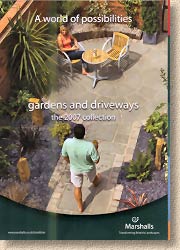
The new brochure opens with a fold-out semi-rigid cover that displays the line-up for Marshalls' 2007 team – drives, gardens, sheds, installers, design, and all the other offerings. This is edged with a contents list, where the catalogue is subdivided into five main sections, which I'll flick through one at a time. As is now compulsory (or so it seems) the first section, a hefty twenty-nine pages is devoted to the whys and wherefores. It doesn't seem all that long ago that if a catalogue stretched to 29 pages, it was considered to be a bit plush! So, we have all the usual ingredients: the buzzwords, the pretty young things, the acquisitive lifestyle, the showpiece homes with acres of space, all as is now expected.
The popular Driveway Visualiser has been given an expanded remit and is now available as a “Garden Visualiser” allowing users to create idealised layouts and 3D views of their patio and summerhouse. These Visualisers get better with each passing year, but as I know from personal experience, there are some clients that resolutely believe the image on the screen or on the print out is exactly as it will be when built. This is the source of the phrase “unrealistic expectations” which rears its overused head whenever a contractor feels the client has placed too much faith in what is, after all, a visualisation and not a realisation. Used with caution, these tools are superb marketing aids for those contractors willing to spend time with clients, or for those clients who like to devise their own layout and then ask for prices from a selection of contractors.

A feature on the three (soon to be four) transformation centres is followed by a plug for the Approved Installer Scheme and the paid-for design service. A further new development, and one I feel should be taken up by other importers, is the decision by Marshalls (which includes the Stonemarket brand) to join the Ethical Trade Initiative (ETI) to ensure their Indian sandstones and other imported materials are produced under ethical conditions, which ensures suppliers guarantee basic principles such as a living wage, no child labour, and the right to belong to a trade union.
Marshalls' Group Marketing Director, Chris Harrop, visited India during December of 2006 and produced a blog of his experience which you can download here. If you're at all interested in the supply and use of imported stone, please spare five minutes to read through Chris's experiences – some of the photos say more than words ever could.

Child labour - an image from Chris Harrop's blog
Garden Paving
Moving in to the real meat of the catalogue, the next section covers what is now termed “Garden Paving”, which basically means flags, both pressed and wet-cast. Almost everything in here has been seen before, but that's not a criticism. If anything, it suggest that Marshalls have arrived at a product mix that suits the current market, and, as a great believer in the tent of “if it's not broke, don't fix it”, I'm quite happy to see a manufacturer prepared to stick with their current hand rather than twist for the sake of twisting.
Of the new developments, it's worth noting that Haworth Moor will, henceforth, be supplied as a calibrated (uniform thickness) product, which will enable screed-bedded laying, a technique that is much faster for installers and less liable to problems in the medium-term. The Eclipse granite paving will be available in a darker colour option, to be known as “Graphite”, and the Bonding-in kit that I've raved about for the last two years is now available for the Heritage circles. While the useless Diarmuid Gavin paving is still wasting valuable catalogue space, its continued existence can be overlooked because the superb Argent paving range has been expanded with the addition of a larger 600x600mm size which makes it even more versatile. Saxon, the shot-textured paving that's been around since … err … since the Saxons, I think, has been treated to its very own Octant kit, which, if there is any justice, will happen with the undervalued Perfecta range in the very near future.
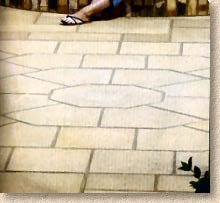
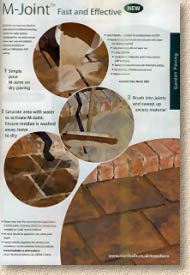
The final page of the Garden Paving section is given over to the M-Joint miracle jointing jollop that was unveiled at Glee last year. I've still not been able to try it out for myself, so I'll reserve judgement for now, but this whole field of non-cementitious, non-staining jointing materials is growing at what seems to be an exponential pace with more and more manufacturers and distributors putting product onto the market.
Whether M-Joint can compete with the likes of Romex and GftK remains to be seen. The Hi-Tech research facility at the bottom of my garden has been readied for in-depth testing as soon as I can get the kids' bikes out of the way.
A buffer zone of sheds, summerhouses and greenhouses has been strategically placed between the garden paving and the Edgings section. It looks as though it should be one of those inserts that flutter out of the Sunday Supplements. What next? Saga Holidays?
Paths and Edgings
I'm not quite sure why Paths and Edgings have been awarded their own section. Perhaps it's because they straddle the boundary between “Garden Paving” and “Driveways”, or maybe it's just an assemblage of products that doesn't really fit in anywhere else. Again, there's nothing revolutionary in here, although, after years of waiting, the Tegula Deco is finally available in the 'Traditional' colour option. I never understood why they weren't available in 'Traditional' from the moment they were launched, but then, that's probably why I'm not employed by anyone. The cobblestone lumpy-pretend-setts-onna-mesh product has two new(ish) colour options (Yorkstone and yawn Old Yorkstone) but I still don't like them and can't think of a single situation where I'd be tempted to use them (unless it was for that bast … bloke down the road that I can't stand!)
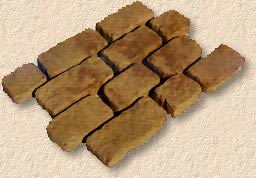
Garden Accessories
Garden Accessories also has its own section, although it might actually be a sub-section as it's kitted out in a paler shade of the green used to colour-identify the Paths'n'Edgings bit. This is a whole new area devoted to decorative aggregates, rockery stone and an intriguing selection of “Special Aggs” that includes black volcanic sand, tumbled blue glass and crushed CDs (I do hope they're mostly CDs from the 1980 – I'd happily pay a small premium for crushed and certificated Bros CDs!!)
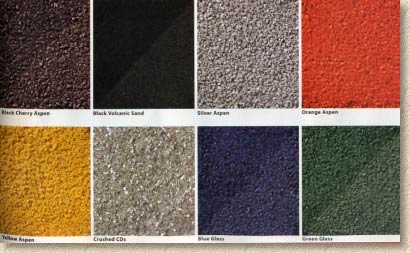
Walling
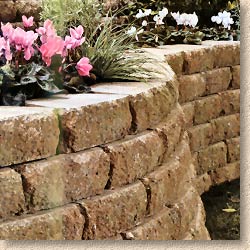
Walling might also be a sub-section, because it shares the green colour identification on the page edges much like the previous two (sub) sections. Yet again, there's nothing totally new, just a few tweaks, including a new “Cotswold” colour for the Tegula walling along with a Tegula Coping and Pier cap that looks suspiciously like a Heritage flag. It's good to see Marshallite walling, like the Saxon Paving, is still holding its own – they take me back to a time when catalogues where little more than leaflets and choice was much, much simpler. It just goes to show that good ideas are timeless.
Driveways
The final section considers Driveways. Looking back at Marshalls' catalogues from a decade ago, block paving dominated the agenda. It was given pride of place on the cover and the opening pages, and acres of glossy paper were devoted to extolling its manifold virtues. This is the fourth or fifth catalogue I've seen this year that has the block paving tucked in at the back, as though it were an afterthought or a slightly dodgy uncle at a family gathering. Is this because our love affair with CBPs is dwindling or because we are overly familiar with what's available from all the major manufacturers?
It's hard not to believe that the market is tiring of concrete block paving. The opening page of Marshalls' coverage is given over to an imported stone block system, sold under the Haworth Moor name. Given the success of Natural Paving's version, launched last year, and considering that Brett have launched a very similar product, this may be the year when we acknowledge that not even the residential driveway market is immune to the onslaught of the Indian stone products. When you compare the price of natural stone blocks to that of even a simple coloured concrete block, and when you consider that installation costs and prep work are essentially identical, then it's no wonder that the more discerning buyers are choosing stone. On the surface, it must seem like the choice between butter and margarine: why have manufactured when you can have natural?
There's no denying that the Haworth Moor setts, in both split and sawn options, are stunningly attractive, and it's not my intention to deter potential buyers of this or any other form of imported stone block paving, but over the last four months I've been re-visiting a number of installation to see how they fare over the wetter, colder, winter weather, and it's slightly worrying to report that I've seen helluva lot of algae and moss. I wouldn't want to claim my monitoring is in any way scientific, but it would appear that many of these products are rapidly colonised by the vegetation, far more rapidly than I've noticed with standard texture CBPs. The ones that have appeared least affected are, without exception, those treated with a sealant. It may be a good idea to bear this in mind if you're tempted by any of these products.
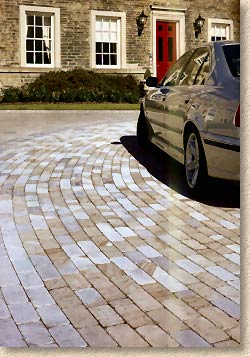
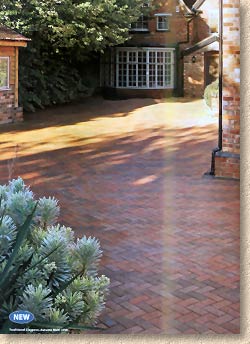
So, as with all of the previous sections (and sub-sections), there's not much new, other than the already-mentioned Tegula Deco in Traditional colour, and a new "Autumn Multi" colour in the clay paving (which Marshalls sold off a few years ago). I've not seen this new "Autumn Multi" in the flesh, but judging from the rather sumptuous photie on page 146 (where is that, Michelle??) it would appear to be a more varied version of the Ashbourne Red Multi that graces my own garden. Of all the new colours, sizes and textures on show in this year's catalogue, this is the one I most want to see for myself.
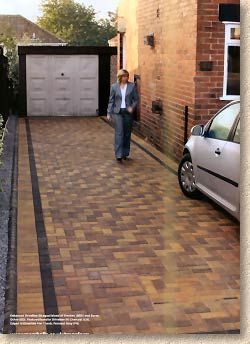
I suppose I should mention that, as revealed at Glee last year, the colours and texture of the Driveline 50 blocks have been "enhanced". The colour is said to be deeper and richer, while the surface is more closely finished, with upgraded wear and fade characteristics. I know the lads and lasses at Marshalls are chuffed as a dog with two … err … sausages, but was there really a need to repeat the Driveline 50 colour swatches on two consecutive pages?
And that, as they say, is about it. There's another tangential buffer zone of two pages extolling the virtues of sectional garages that you ought to be able to shake loose, but can't, and then you're on the last page. The installation information has been massively reduced to a few paragraphs of very dry text, with no illustrations at all. When you consider that Brett have actually gone in the exact opposite direction by providing extended and enhanced tech info in their catalogue – oops, their Directory, I should say – then you have to wonder whether Marshalls actually want any DIYers or non-Registered installers using their products. I know that the pack and size information, and more detailed installation guidance is given in the Installers Guide provided to those contractors stumping-up the membership fee, but what about the thousands of good contractors that choose not to hand over money to a manufacturer in order to ply their trade, and what about all those keen and competent DIYers that prefer to take on this type of work for themselves?
In summary, there's no denying the Marshalls 2007 catalogue is another must-have for any serious contractor or anyone considering a decent driveway or patio in the coming year. The images are wonderful and there's a lot of smaller photies that show some clever design options that are easily overlooked. The text, by and large, fills the white space between the images, but makes all the right noises. The product info is sparse, and this does seem to be a trend with Marshalls. The omission of comprehensive technical and installation information is a retrograde step, in my opinion, but it's important to bear in mind the overall strategy now being run by Marshalls. They are no longer happy with just supplying the paving: they want to supply the designer, the contractor, the finance, the garage, and the garden shed to go with it, and this catalogue is very much in line with that game plan.
To get your own copy of the latest Marshalls' catalogue, call their Customer Helpline on ...

Normally, I'd recommend sending an enquiry via their website, but it takes so bloody long to load, even on broadband, that's it's quite possibly quicker to walk to Halifax and ask for a copy rather than wait for all that silly Flash nonsense to download and then to spend half your lunchtime wondering where the contact form might be.




